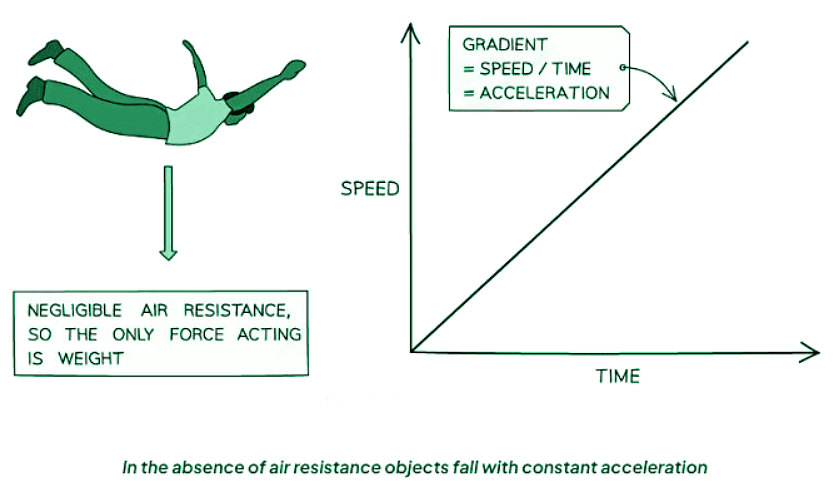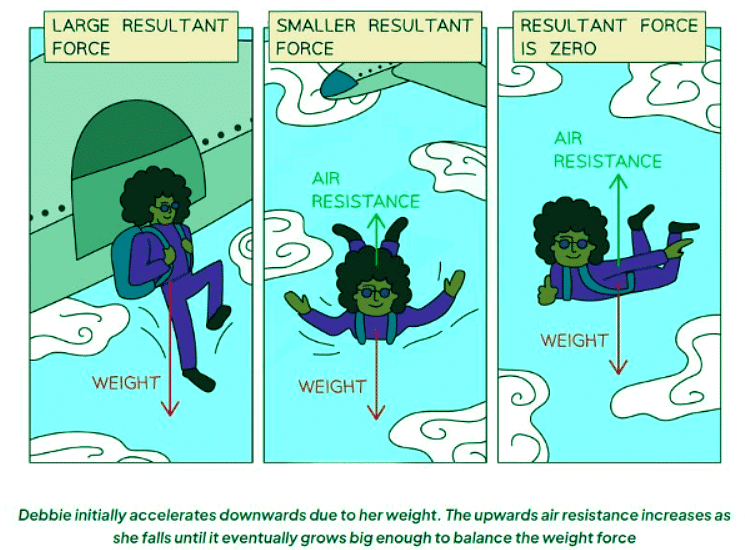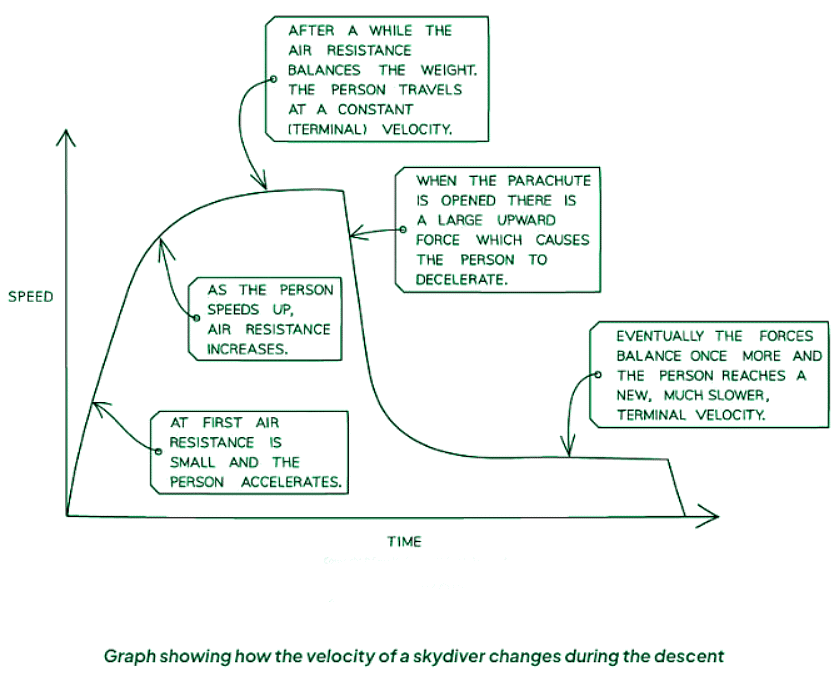Class 10 Exam > Class 10 Notes > Physics for GCSE/IGCSE > Freefall
Freefall | Physics for GCSE/IGCSE - Class 10 PDF Download
Acceleration of Free Fall
- Without air resistance, every object descends with identical acceleration.
- This phenomenon is termed as freefall acceleration, alternatively known as gravity's acceleration.


Galileo observed that in environments lacking air resistance, all objects (near the Earth's surface) descend with an acceleration approximately equal to 9.8 meters per second squared.
- For each second of descent, the object's velocity rises by 9.8 meters per second.
- The symbol "g" represents the gravitational field intensity and is utilized to compute an object's weight by its mass:
weight = mass × gravitational field strength
W = mg
Motion of Falling Objects
Falling Objects without Air Resistance
- Without air resistance, all objects falling within a consistent gravitational field experience the same acceleration, irrespective of their mass.
- As long as air resistance remains negligible, the velocity of a falling object will consistently accelerate, progressively increasing with time.

Question for FreefallTry yourself: What is the term used to describe the phenomenon where all objects near the Earth's surface descend with the same acceleration?View Solution
Falling Objects with Air Resistance
- When objects fall through fluids (liquids or gases) in a uniform gravitational field, they experience two main forces:
- Weight: This force is due to gravity.
- Friction: Such as air resistance.
- Skydiver's Experience
- When a skydiver jumps from a plane, they encounter:
- An acting force of weight (mass × acceleration of freefall) directed downward.
- An acting force of air resistance (frictional forces always oppose the direction of motion) directed upward.
- When a skydiver jumps from a plane, they encounter:
- Air Resistance Increase with Speed
- This force grows with velocity, as illustrated in the accompanying image.

Understanding Terminal Velocity in Skydiving
When a skydiver jumps out of a plane, several forces come into play that determine their speed and motion. Let's break down the concept of terminal velocity step by step:
Initial Stage of Freefall
- Initially, the upwards air resistance is minimal since the skydiver is not falling rapidly.
- Due to this slow fall, there are unbalanced forces acting on the skydiver at the beginning.
Increase in Falling Speed
- As the skydiver accelerates and gains speed, the air resistance they experience also increases.
- This increasing air resistance eventually reaches a point where it balances out the downward weight force acting on the skydiver.
Attaining Terminal Velocity
- When the air resistance equals the weight of the skydiver, the forces acting on them are balanced.
- At this point, there is no longer any resultant force affecting the skydiver's motion.
- As a result, the skydiver's acceleration becomes zero, and they continue to move at a constant speed.
- This constant speed that the skydiver reaches is termed as their "terminal velocity."
Terminal Velocity in Skydiving
- When a skydiver deploys the parachute, the air resistance experienced by the skydiver increases.
- This increase is primarily due to the larger surface area created by the parachute opening.
- The upward force of air resistance acting on the skydiver also increases, leading to a decrease in the acceleration of the skydiver's fall.
- As a result, the skydiver starts decelerating.
- Eventually, a new equilibrium is established where the forces balance out, and the skydiver reaches a slower terminal velocity.
Factors Contributing to Terminal Velocity
- The increased surface area of the parachute.
- The upward force of air resistance counteracting the force of gravity.
- The concept of deceleration and reaching a new equilibrium point.

Question for FreefallTry yourself: What is the main force that acts on a skydiver during freefall?View Solution
The document Freefall | Physics for GCSE/IGCSE - Class 10 is a part of the Class 10 Course Physics for GCSE/IGCSE.
All you need of Class 10 at this link: Class 10
|
126 videos|182 docs|35 tests
|
FAQs on Freefall - Physics for GCSE/IGCSE - Class 10
| 1. What is the acceleration of free fall? |  |
Ans. The acceleration of free fall, denoted as "g", is the acceleration experienced by an object due to gravity when it is falling freely in a vacuum. It has a constant value of approximately 9.81 m/s^2 on the surface of the Earth.
| 2. How does air resistance affect the motion of falling objects? |  |
Ans. Air resistance is a force that opposes the motion of an object through the air. When an object falls, air resistance can slow down its acceleration and affect its velocity. As the object's speed increases, air resistance also increases, ultimately reaching a point where it balances out the force of gravity, resulting in a constant velocity known as terminal velocity.
| 3. What factors can affect the acceleration of free fall? |  |
Ans. The acceleration of free fall is primarily determined by the gravitational force acting on an object. Factors such as the mass and distance from the center of the Earth can affect this acceleration. However, in a vacuum, where there is no air resistance, all objects will accelerate at the same rate regardless of their mass.
| 4. How is the acceleration of free fall measured experimentally? |  |
Ans. The acceleration of free fall can be measured experimentally using a simple setup involving a falling object and a timer. By dropping the object from a known height and measuring the time it takes to fall, one can calculate the acceleration using the equation: acceleration = 2 * (falling distance) / (time taken)^2.
| 5. Can the acceleration of free fall change in different locations on Earth? |  |
Ans. While the acceleration of free fall is approximately 9.81 m/s^2 on the surface of the Earth, it can vary slightly in different locations due to factors such as altitude and the Earth's rotation. However, these variations are usually minimal and can be considered constant for most practical purposes.
Related Searches















